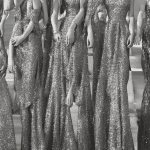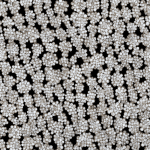Layering necklaces might seem like a simple task, but lo and behold, is it a trickier endeavor than you’d ever imagine. It’s not just about slinging on chains of varying lengths and hoping they’ll magically look chic. It’s an art, a delicate dance of style and balance. There are different types of necklaces to consider, various lengths to juggle, and countless styles to navigate. If you’re feeling a little lost in the sea of jewelry trends, fret not! We’re here to guide you through the labyrinth of necklace layering so that you can create an ensemble that will turn heads and make you feel like a million bucks.
Understanding the Different Types of Necklaces
Before diving headfirst into the world of necklace layering, it’s important to familiarize yourself with the different types of necklaces available.
A découvrir également : How Can You Make an Eco-Friendly and Pet-Safe Living Room?
Chokers sit high on the neck and are typically tight-fitting. They’re great for adding a touch of drama to your outfit and draw attention to your neckline.
Princess necklaces are a tad longer, sitting just below the throat. They’re versatile and can be worn with virtually any outfit.
A découvrir également : How Are Augmented Reality Maps Enhancing Navigation and Exploration in Outdoor Activities?
Matinee lengths fall somewhere between the collarbone and the bust, making them ideal for both casual and business wear.
The longest of them all are the opera and rope necklaces, which fall below the bust or can be looped to create multiple layers.
Each of these necklaces come in different styles, from simple gold or silver chains to those with pendants or intricate designs. By understanding the different types of necklaces, you can better plan your layering strategy.
Choosing the Right Lengths
The next step in your layering journey is choosing the right lengths for your necklaces. This will make the difference between a well-executed, chic look and a cluttered, tangled mess.
The trick to achieving the former is to ensure that there’s enough space between each chain. Each piece should have its own "zone" to shine. Start with a choker, then add a princess necklace, followed by a matinee length, and finally an opera or rope necklace if you’re feeling adventurous.
In terms of actual measurements, aim for a difference of 2-4 inches in length between each necklace to keep them from tangling.
The Art of Mixing Thin and Thick Chains
Once you’ve got the basics down, it’s now time to mix and match your necklaces. The key to pulling off a layered necklace look is balance. You don’t want to wear multiple chunky chains together, as this can look too heavy and overpowering.
Instead, mix thin and thick chains together for a more balanced look. Start with a thick choker as your base, then add a couple of thin princess or matinee length chains. This will create a contrast and allow each piece to stand out without overwhelming your outfit.
If you want to add a pendant, place it on a thin chain and make it the centerpiece of your look. A pendant will add a focal point to your ensemble and bring all your pieces together.
Choosing the Right Materials
When it comes to the materials of your necklaces, consistency is key. Mixing together gold and silver chains can result in a disjointed look, especially when you’re layering multiple pieces.
If you’re a fan of gold, stick to gold chains of various styles and thicknesses. The same goes for silver. However, if you’re keen to mix metals, do so with caution. Make sure there’s a unifying element among your pieces, such as a similar design or pendant, to tie them all together.
Layering for Different Occasions
Finally, remember that not all occasions are suitable for a heavily layered necklace look. For a casual day out, a simple stack of two to three necklaces is more than enough to add a touch of style to your outfit. For formal events, you can go all out with multiple layers and a statement pendant.
Always take into consideration your outfit and the event you’re attending. This will help you determine the type, length, and style of necklaces to wear. Remember, the key to successfully layering necklaces is balance, so play around with your pieces until you find a combination that works for you.
Incorporating Different Styles and Pendants
In the realm of necklace layering, the incorporation of various styles and pendants can take your look from ordinary to extraordinary. When layering necklaces, you don’t have to stick to one style or type of chain necklace. In fact, the amalgamation of different designs can add depth and visual interest to your ensemble.
For instance, you can mix a minimalistic gold chain with a more ornate princess necklace. Adding pendant necklaces into the mix can also elevate your look. Consider choosing pendants that complement each other or have a common theme. For example, if you’re wearing a sterling silver, consider adding a pendant with a silver accent. This can create cohesion among your layered necklaces.
But be cautious when dealing with the chunky chain. It’s a bold piece that can easily dominate the look. So, it’s often best to pair a chunky chain with thinner, more delicate necklaces to maintain balance.
However, remember to avoid overloading on pendants. Too many can make your layered necklace look cluttered rather than chic. Stick to one or two standout pendants and let these be the stars of your necklace layering show.
Ensuring Comfort While Preventing Tangles
Even with the most stunningly layered necklaces, discomfort or the constant annoyance of necklaces tangling can mar your experience. It’s vital to ensure that your necklaces are comfortable to wear, especially when you’re layering several pieces.
When choosing necklaces, pay attention to the weight of the pieces. A chunky chain may look great, but if it’s too heavy, it could cause discomfort throughout the day. Opt for lightweight pieces, especially for necklaces that are closest to your neck.
To prevent your necklace layers from tangling, consider using a necklace separator or detangler. Some layered chain necklaces come with these built-in, but you can also purchase them separately. They ensure that each chain maintains its own ‘zone’, reducing the chances of interweaving.
Also, remember to give your necklaces a gentle shake or adjustment from time to time. This can help in preventing tangles and keep your layered necklaces looking their best.
Conclusion
Layering necklaces is not just a fashion statement; it is an art form. It requires a keen understanding of the different types of necklaces, lengths, and materials, and how to effectively mix and match these to create a balanced and visually appealing look. But with practice and a little bit of experimentation, you too can master the art of necklace layering.
Whether you prefer gold or silver chains, thin or chunky chains, with or without pendants, the options are endless. Remember, the goal is to express your unique style and personality through your layered jewelry pieces.
By following these best practices for layering thin and thick necklaces, you can confidently step out in style, turning heads with your chic and unique layered necklace ensemble. So, don’t be afraid to try out different combinations and create a signature look that’s distinctly you. Happy layering!










